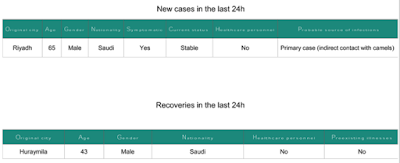 |
#11,705
The slow trickle of primary (community acquired) MERS cases continues to emerge out of Saudi Arabia - mostly due to camel contact - as 3 million religious pilgrims prepare to take part in this year's Hajj.
This summer the good news is the the number of cases reported by KSA is markedly lower than last year, primarily due to a lack of nosocomial outbreaks.
Unknown, of course, are the number of asymptomatic, mild or moderate infections that never seek hospital care - and are therefore never tested - along with the number of severe cases that are misdiagnosed.
A recent report (see EID Journal: Estimation of Severe MERS Cases in the Middle East, 2012–2016) estimated the true number of severe cases is 2.3-times higher than the total number of all laboratory-confirmed cases combined (including mild and asymptomatic) cases in the region.
We've seen other attempts to estimate the incidence of MERS in Saudi Arabia (see Presence of Middle East respiratory syndrome coronavirus antibodies in Saudi Arabia: a nationwide, cross-sectional, serological study by Drosten & Memish et al.,) - and while the numbers vary widely - they all suggest the true number is much higher than has been reported.
All of which means that even with the reduced numbers we are seeing, public health agencies around the world must be alert for returning pilgrims showing any signs of MERS.
Meanwhile, today's report shows a 65 y.o. Saudi male hospitalized in stable condition with a history of `indirect' camel contact.
Note: Last November's EID Journal: Risk Factors For Primary MERS-CoV Infection, defined indirect camel exposure as: Having visited settings where animals were kept but without having direct contact; or exposure to household members who themselves had direct animal exposure.
